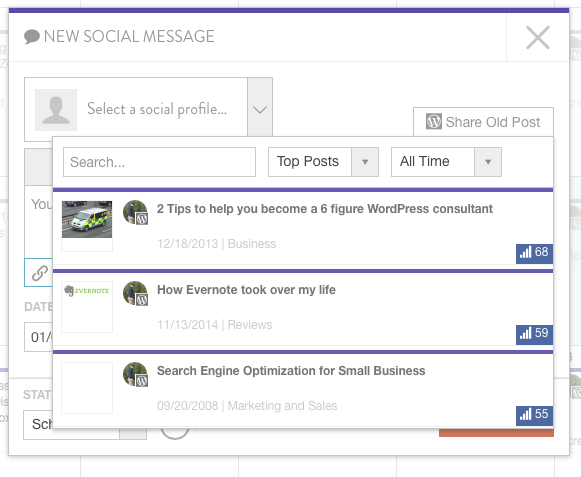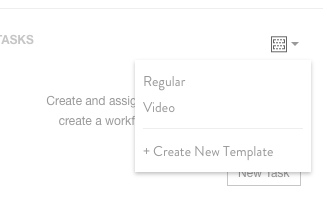I believe we all know the power of sharing when it comes to building an online audience. But now that I’m posting here regularly, sharing this content could be a really big job; something I’d have to give my attention to a few times a day.
However, while I do want to share my content and build my audience, most of my attention needs to go to serving my clients and running my business. Manually sharing content would take time away from other things I feel are more pressing. Yet it IS important for me to lead the way in spreading my message, because if I don’t tell people about it, then few others will do that for me.
So today I want to tell you about two tools that are helping me manage my social content.
CoSchedule
CoSchedule is an app that lets you manage multiple social tasks from one place. While one key feature for me in CoSchedule is its ability to schedule the social media posts for my content, it’s by no means the feature I use the most.
Any post that you see on this site starts in CoSchedule. I push the post as a scheduled post to WordPress and within about 2 seconds I’ll see it in the CoSchedule interface on the calendar.
Then I can assign some tasks to the post, such as adding an image or link before publishing. Even better, I can save task templates, which allows me to add 3 or 4 tasks with only a few clicks.
My standard tasks for a post are:
- Edit post (and I assign this to my excellent editor)
- Get featured image
- Schedule social media posts
Once the post is written and these tasks are assigned in CoSchedule, I leave the post until the Friday before it’s scheduled to be published. Every Friday I go over the posts for the next week, read them over, get the image I need, then schedule the social media posts for the content.
I typically schedule 3 different posts to Twitter on the day each piece of content releases, and then add it to Buffer 1 week after it’s published — 1 month, 60 days, 90 days, 120 days. Here’s an example of what my scheduled social media posts look like within CoSchedule.
Then I just let CoSchedule handle the sharing for me.
Finding Old Content
But CoSchedule does more than that when it comes to sharing your content, it helps you find popular old content and schedule social media posts for that content.
Notice I said popular, not valuable. The sorting tools provided by CoSchedule are purely built around what articles were shared the most on social media already.
From the CoSchedule interface you click the little pencil in the top corner and then can choose which type of content you’re going to add. When you choose social media you’re presented with the dialogue below.

Here you can sort your posts in multiple ways to find content that you should share. The little number and ‘graph’ on the bottom corner of each post is how many times it was shared on social media. If you look at the image above you’ll note that my post on Evernote is there so it must have been shared lots right?
Sure it was, by me as I was advertising a contest I was running. I’d guess that 80% of that sharing is entirely a result of me and while I think the post is valuable I’m not convinced that it should really show up where it is solely based on my sharing it.
You can limit your filtering by time (This Year, Last Year, This Month, Last Month) to see which posts were popular. It also provides a filter for posts but the only options are Top Posts, My Posts, and a generic filter for everything.
I could see just wanting to see my posts on o multi-author blog, but I’d still want to see which ones are popular and you can’t do that.
Once you’ve got your post picked you can choose the day you want to share it or you can send it to Buffer on a specific day. You can also choose which profiles you want to send content to.
I currently only have my Twitter profile and my Linkedin profile setup. I don’t really use Facebook and the only thing you can share to on Google+ from CoSchedule is a page, which I don’t have.
I use the sharing tools here sometimes. I used them for the last 2 weeks of December because I wanted the vanity metric of December 2014 being higher traffic than December 2013. I got it, but it didn’t actually translate in to more customers (a few email sign ups) which is why I call it a vanity metric.
One thing this doesn’t do is schedule old content automatically like Revive Old Post does.
It’s awesome but…
In spite of all the awesomeness that CoSchedule provides, there are a few drawbacks.
First, I’ve reported bugs in the UI and function of the app on what seems like a weekly schedule. The most often repeated bug is tasks not actually resolving after I’ve checked them off. They look resolved but when I come back later they are still incomplete.
Now CoSchedule support has been super fast to fix anything I’ve mentioned (typically within 24 hours) but it would be great to see improvement in the stability of their application.
A second annoyance is always signing into the CoSchedule calendar in my WordPress install. It’s great to have the calendar right there for easy viewing when I’m in WordPress already, but since it’s embedded in my WordPress blog, 1Password doesn’t recognize and auto-fills the password.
One would think that if I’m signed into the CoSchedule app in the same browser, the calendar in WordPress would just let me see it without prompting me to sign in again.
One would be wrong though.
Overall, I really like CoSchedule and it works very well with my editor. I’m quite happy paying for the service and they have one of the best newsletters for content creators. I can spend 20 minutes on Friday to schedule the social posts for all my content for a whole week, and that’s a way better use of my time than manually remembering to tweet posts the day they come out.
Revive Old Post
As I mentioned above CoSchedule doesn’t have a way to automatically share old content for me. There is lots of high value content on this site that for one reason or another simply didn’t resonate the day I really pushed it on social media.
That means they’re never going to show up in the CoSchedule filtering fields unless I drill down through 200+ posts in 2014.
This is where Revive Old Post comes in, it automatically looks through your old content and shares the content. I’ve had lots of traffic from posts automatically shared.
I set mine to 1 Tweet every 29 hours, so you really shouldn’t see it much.
One problem is that sometimes it tweets things that it probably shouldn’t like recently when I tweeted a ‘launch’ of a product that happened in August 2013.
https://twitter.com/curtismchale/status/553383820859559936
At one point you could exclude specific posts from this WordPress plugin but you can’t anymore. My only option is to create a category that all ‘launch’ posts would go in to and then they’d simply be excluded from the plugin.
I may do that, or I may explore other options we’ll see.
One note is that some people really dislike this plugin. I have a few friends that mute the whole thing so they never see any Tweets from it. They figure they’ve already seen all the ‘great’ content out there and saved it.
As a blog owner I’m going to disagree. I see signups to my email list once a week that are tracked back to this plugin. As a Twitter user I’m going to say maybe. Seeing accounts that only ever tweet content sucks.
I try not to be that way because I genuinely like interaction on Twitter, but I’m sure sometimes I fail at that.
Buffer
My third social media tool is Buffer. I started using Buffer when I had some ‘complaints’ from people who follow me. I had a habit of reading through much of my Instapaper queue in one sitting, so within a few hours I would share a whole lot of links in short order.
I kind of agree, that’s a bit spammy, so I started to send all those awesome links to Buffer, which let me take care of my tasks in one session, but still be considerate of my followers.
One of the added benefits of that is I can use utm_* parameters to show that I was the source of traffic to someone’s site.
That feels like a bit of vanity for sure, but I’ve made 2 good contacts on other blogs I like because they noticed me sharing their links and directing traffic to them.
As much as I dislike spammy marketing stuff, I do want my content to reach as far as possible and I want to grow my influence and readership. Marketing tools help me strike a good balance between promoting my content but still devoting my attention to my clients and my business.
That’s it for my social tools, really. Buffer and CoSchedule and Revive Old Post help me limit my time on social sites but still share the content I think is worthwhile.
photo credit: 50997200@N07 cc



4 responses to “CoSchedule, Revive Old Post, and Buffer: My Social Content Tools”
I’ve been using Evergreen Post Tweeter for years and like it. It allows you to set a minimum age of the post so that I’m not posting things that are too old and irrelevant now. Except in thinking about posting more Evergreen type content, this seems counter intuitive.
How you are tracking your newsletter sign ups to the link from Revive Old Posts plugin?
It puts on UTM parameters and Leadin tracks where new ‘leads’ come from so yes I am. There isn’t a great way to segment the users that came from there though. I could set up a goal in Google Analytics though and segment with that.
Gotcha – Leadin is another tool I’m looking into getting involved with. Right now I just have GF tied into Mailchimp – no tracking going on which is really pretty bad since I don’t know where people are actually coming from unless I look at each thing individually.
Hi Curtis:
This is similar to what I use to share content, except I rely more on Revive Old Post as a substitute for CoSchedule. I usually load my Buffer before bed. (I email myself links to read and share as I see them online or on Twitter. The best ones I load into Buffer).
I think Revive Old Post still has an Exclude Posts option. I use it to leave out posts that aren’t timely anymore, or where the information is no longer the same.
CoSchedule is something I’ve been wanting to check out, but I move really slow. I only adjust small things each day/week/month when it comes to sharing flows.